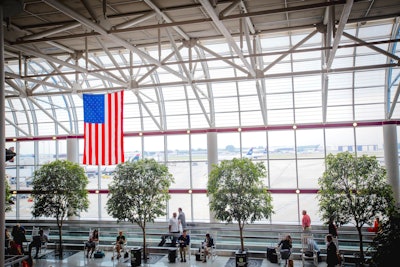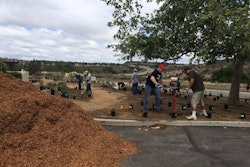
Interior plantscaping practices are similar to those of landscape design, using plants to provide a living element that is both beautiful and functional.
Here is a brief look at some of the value they offer to indoor spaces:
Focal points
Just as some trees can be used as a sculptural centerpiece in a backyard, large specimen plants can serve as focal points within large indoor areas. These plants can direct individuals toward their destination. When using them, take care to keep other plants nearby low and simple so as not to distract from the specimen plant.
Colorful masses of vegetation can also work together as a focal point. How fast you are trying to move people through a space will determine whether you need to use uniform plants in a straight line or a winding path of various species.
Depth and spaces
Large, open spaces can make people feel vulnerable, but plants are able to break up a room into more intimate spaces. A cavernous lobby can be off-putting, especially to someone who has never been there before. Added greenery can work as a divider, creating temporary nooks while maintaining the essential openness of the design.
Lower ceilings
High ceilings may be awe-inspiring in a cathedral, but shopping malls and other places with towering ceilings come across as intimidating. Well-spaced palm and ficus trees can create a lower “ceiling” – a canopy of foliage.
This design can be kept airy by having two levels of vegetation to lower the perceived height of the space without being too thick overhead.
Acoustics
Any location where a large amount of people gather is going to sound a lot louder if there are only hard surfaces around. Plants are effective at absorbing sounds, especially high-pitched frequencies.
Research shows that ficus trees, dracaenas, peace lilies, arboricolas, and heart-leaf philodendrons are particularly effective at making spaces less noisy. Bark mulch can also be used for noise absorption.
Framing and screening
If plants themselves aren’t the focal point, they can help direct people toward whatever is the center of attention by framing it on either side. Anything from an elevator to a doorway to a lobby desk to a piece of artwork can have plants flanking it to increase its visibility.
They can also do the opposite by hiding the necessary but unattractive components of a fountain, or shielding an unattractive view without completely blocking out the incoming light.
Color
In a drab office maze of cubicles, multiple shades of green can come to the rescue and breathe life into a place. Even buildings that already have paint colors other than taupe and beige will benefit from the addition of plants, which can be used both to complement and contrast the elements in the space.
Plant leaves’ varying textures and shades can be used to provide interest in subtle or vibrant ways, depending on the ones you choose.
Ambiance
 The Charlotte Douglas Internation Airport is an example of interior plantscaping making a space more soothing with its sturdy trees soaking up the sun.
The Charlotte Douglas Internation Airport is an example of interior plantscaping making a space more soothing with its sturdy trees soaking up the sun.Photo: N i c o l a/Flickr
While usually thought of in a positive context – a romantic ambiance, a soothing ambiance – the atmosphere, or mood, of a given space can also be negative. It’s more likely to be pleasant with the addition of plants.
While their aesthetic contribution is important, plants also function to pull together disparate features, and that unity goes a long way toward ensuring the overall space is comforting rather than jarring.
If a space is minimalist and contemporary, the plants should follow suit in being simple and modest. Southwestern or desert spaces would obviously use cacti and succulents. Each space has its own emotion it is trying to convey and plants help transmit that message.
Environment
Plants not only filter sound but are also able to create a better environment indoors. For those seeking Leadership in Energy and Environmental Design (LEED) certification, limiting the presence of volatile organic compounds (VOCs) is imperative. Plants are able to absorb and convert these compounds into food, improving the air quality while lowering the humidity and temperature of an indoor space.
Well-being
The health benefits of plants are one of the most obvious and frequently cited bonuses of having plants indoors. They are able to reduce mental strain and soothe the body and mind. Simply being around plants can put people more at ease and improve productivity.










